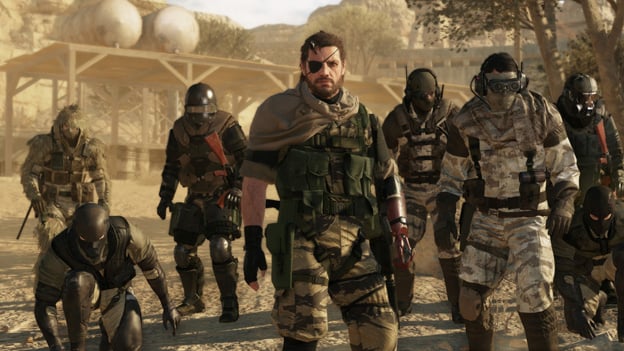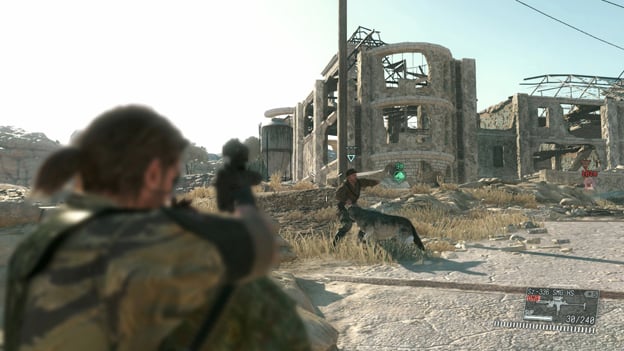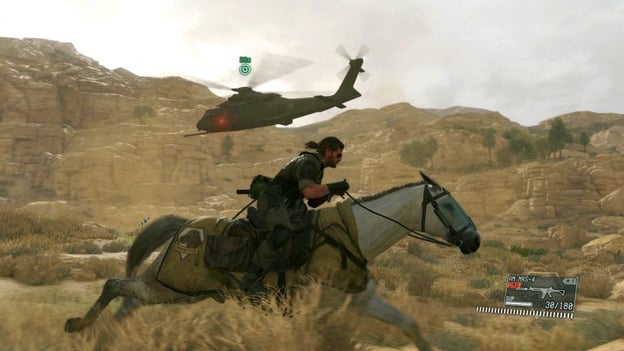Open-world revenge never tasted so good…
I remember feeling overwhelmed in Metal Gear Solid 3: Snake Eater due to the sudden shift in setting. Instead of taking place in urban settings like the first two games, where radar technology was so advanced that I could see my enemy’s field of vision, it took place in the jungle where I had to rely situational awareness to keep track of my enemies and camouflage to blend in with the jungle. Every MGS after the third would increasingly open up, allowing us more and more options to complete missions, and eventually giving us the ability to recruit other soldiers. Now that Metal Gear Solid V: The Phantom Pain has been released, I’m not sure how Kojima could continue to expand on the series now that it’s open world; it felt like playing MGS 3 for the first time all over again.
The Phantom Pain continues the story’s penchant for intense military drama combined with absurdity, perfectly suited for blowing our minds. The events of MGS 5 take place 9 years after Ground Zeroes, the demo Konami released last year that was essentially the equivalent to the tanker mission in MGS 2. At the end of Ground Zeroes, Snake and his army are ambushed by Cipher and his organization who destroy Militaires Sans Frontières, the mother base he had built in Metal Gear Solid: Peace Walker. Eventually, Snake wakes up, missing an arm, stuck with a piece of shrapnel in his head that causes him to forget Russian, and is prone to hallucinations. After surviving the bizarre events in the hospital, the rest of the game is about rebuilding his army and exacting revenge against Cipher.
As I said earlier, the story is as absurd and emotional as the rest of the series. If you’re a fan of Hideo Kojima’s writing style and have been invested in the series’ long tale leading up to the events of the first Metal Gear, then you’ll be entranced by the story. He has changed his pacing, however. Kojima presents the story episodically, which makes the game feel like a television series. What’s really surprising is the sparse amount of dialogue, at least when compared to the previous games. While Snake still communicates with his allies in the field, he is no longer bombarded with long, tedious codec calls designed to fill him in on backstory. I understand that there are many fans who will miss these calls, myself being one of them, but the alternative Kojima provides is a series of cassette tapes filled with debriefings. You find these tapes, which contain conversations between Snake and other various characters, throughout the open-world map. Otherwise, you can listen to Ocelot give you tips in the field while still being able to move around. Not only is this story a satisfying conclusion to Big Boss’s tale, but its pace is perfectly tailored for the open-world environment.
Speaking of open world, The Phantom Pain takes some getting used to. The previous games are linear yet allow us freedom to use whatever items and tactics we want. In MGS 5, however, you get to pick the landing zone of the helicopter, as well as how long you wish to remain in the area. Most of the enemies are confined to bases set up in Afghanistan; however, I still had to remain somewhat stealthy in the middle of the desert, as enemy convoy could appear suddenly. If I felt too endangered, I could even run away from a base to hide deep in the desert, eventually finding a cliff perfect for surveying the area. For once in the series I was free to go where I wanted to, but I began to miss the linear progression with minor backtracking as I became paranoid that I would alert the enemy without even knowing he was there.

This is when I learned that the binoculars and the iDroid are my best friends in this game. Most of the missions, which despite the open world are structured similarly to the ones in Peace Walker (i.e. pick and choose, then go straight to base), I start by surveying the base from with my binoculars, which I can use to tag the enemies, allowing me to see them as red dots in the distance or even as electronic skeletons when they’re behind walls. While this might seem like it cheapens the difficulty, I can assure you it doesn’t, as you still need to find each enemy to be able to plan your tactics efficiently; I can’t count the number of times I thought my plan was going smoothly only to be spotted by an enemy I myself had failed to spot. Not that it matters too much because the enemy AI, although noticeably the most intelligent in the series, still had trouble spotting me in alert mode while I was hiding in something that offered minimal protection such as grass.

Beginning with MGS 4, the series has become slightly more accommodating to players who do not appreciate or are not skilled in stealth, but regardless of one’s play-style, the controls and camera are more seamless than ever. The open-world allows for plenty of movement for the camera. Aiming is accurate and can be done over the shoulder or first-person, depending on one’s preference. CQC techniques simply require sneaking up on an enemy, grabbing him with the shoulder button (R2 with the PS4’s controller) and then choosing whether to kill, knock out, or interrogate him with the corresponding face button. There’s plenty of leeway regarding how you approach each mission, but whatever kind of soldier you are, MGS 5 has a spot for you in its squadron, even if it does grade you harshly if you’re not stealthy or quick enough.
The Mother Base is a feature carried over from Peace Walker which adds even more customization beyond one’s approach to the gameplay. With Fulton System, Snake can capture enemy soldiers and recruit them to expand his army. I highly recommend investing your GMD, the currency you acquire from missions and exploration, in research and development so that you can bring new weapons and items into the field. Soldiers have different skillsets, with some being more suited for R&D and others for fighting; however, you can assign soldiers wherever you like. You can also recruit special soldiers, like interpreters, giving you plenty of reason to explore the open world and, by association, the side ops. They all count towards Big Boss’s mission, after all.

In addition to the most polished gameplay the series has seen to date, the presentation is top quality. While the game suffers from the usual graphical flaws of all open-world games, such as lower quality character models (although they’re still quite detailed) and pop-in graphics, the world truly feels alive. It’s filled with flora and fauna, and enemies change their routes depending on their schedule (read: whether it’s night or day). The television style compliments the series’ penchant for cinematic storytelling, and the voice acting is suited for the darker tone of the game. Speaking of which, I miss David Hayter’s gravelly voice, although I feel like Kiefer Sutherland is more suited for the role of Big Boss in this game. As with all of his games, Kojima made sure to craft a game that’s well-suited for the current generation of hardware.
It’s a shame that this will be Kojima’s last MGS game, but for what it’s worth he set aside whatever ill feelings he might have against Konami to create one of his most ambitious games yet. Metal Gear Solid V: The Phantom Pain is the best entry in the franchise, and you should enjoy it while the franchise still has a solid reputation. Thanks to the open-world gameplay, Kojima has given you dozens of hours to remember him and his work.
RATING OUT OF 5 RATING DESCRIPTION 4.5 Graphics
While the game suffers from the usual graphical flaws of all open-world games, the world truly feels alive. 4.3 Control
The controls and camera are more seamless than ever. 4.0 Music / Sound FX / Voice Acting
All the sights and sounds you’ve come to love from Kojima and a Metal Gear title. 4.5 Play Value
The absolute best entry in the franchise, hands down! 5.0 Overall Rating – The Best
Not an average. See Rating legend below for a final score breakdown.
| Review Rating Legend | |||
|---|---|---|---|
| 0.1 – 1.9 = Avoid | 2.5 – 2.9 = Average | 3.5 – 3.9 = Good | 4.5 – 4.9 = Must Buy |
| 2.0 – 2.4 = Poor | 3.0 – 3.4 = Fair | 4.0 – 4.4 = Great | 5.0 = The Best |
Game Features:
